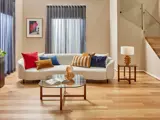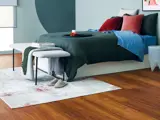With Netflix and other streaming services available, a media room has never been more fun to make a reality. Creating a media room work in the home comes down to really well planned out and thought out flooring solutions for maximum enjoyment for lazing on the floor and to ensure harmonious sound acoustics. Ultimately the best flooring for a media room is carpet and to help you, read tips from our buying carpet guide.
Carpeted floors help control sound through their absorption and prevention of what is known as reverberation around the room. If you’re super serious about your media room, home renovators could consider wall to wall carpeting or carpet tiles to maximise sound as it travels through the room.
If you are going to make a considerable investment into your media room for sound, it’s important to ensure the acoustical balance is in check. Media is such a large and diverse area of collaborative creation, so it would be really important to be clear on what exact dreams you envisage for your space. For example, movie lovers wanting a surround sound experience for blockbuster movies or musicians beating out sound music or large instruments will need to consider subwoofers that are meant to be sitting on the floor to enhance the base presence. However, if bass frequencies are played low to the ground, carpet flooring options will enhance the sounds be emitted. This can make a major difference to the music produced.
Reverberation is the sound that stays in the room after the source of the sound stops. Like in a movie if there is an explosion, the explosion sound slowly drifts away from the room. Sound rebounds off hard timber flooring easier and will travel further so a media room set up with hardwood timber flooring could easily turn a sound system that cost you big bucks into an audio headache! When sound waves spring freely off hard surfaces you will also see a huge impact on the audio precision. Wood or laminate flooring provides a slower sound decay and tend to have a booming quality – for example when you hear music in a gym so be sure to have soft furnishings like couches, cushions and floor rugs which are available in hundreds of fun colours and textures.
Floating floors are a good option for media rooms because you can use underlay that adds clarity to the sounds being produced. Dependent upon what activities you will be delivering in your media room, floating floors come in so many different shapes, styles, colours and types. You can also look at luxury vinyl flooring which comes in so many natural timber colours. It snaps together board to board and some can also be glued to the subfloor. Anything that you can glue to the subfloor means that you can personalise the room’s acoustic balance with specific types of underlay relative to the sound the room will be producing.
Engineered flooring is another flooring option for you to consider. Engineered wood flooring such as Plantino Engineered Oak is nailed to a plywood substrate. Again, this means you can play with the underlay choices that are on option to you. However, if you were not sure of the room, you can install on a floating basis speak to one of our flooring specialists at over 140 Choices Flooring stores around Australia. Find a flooring store near you.
It is important to understand that floating floors, specifically when it comes to a media room, use thinner materials. This will only become a problem for your media room if you don’t attach it a substrate. The great advantage of floating floors is that it’s easy to remove which means its adaptable to a changing environment and it’s also much cheaper than other flooring options.
Before you make any hard and fast decisions be sure of what you want and what sort of use your media room will have. That can all help lead you to a really positive flooring decision and one that you will be satisfied with when munching on popcorn and choc tops during your favourite sports game or blockbuster movie.







